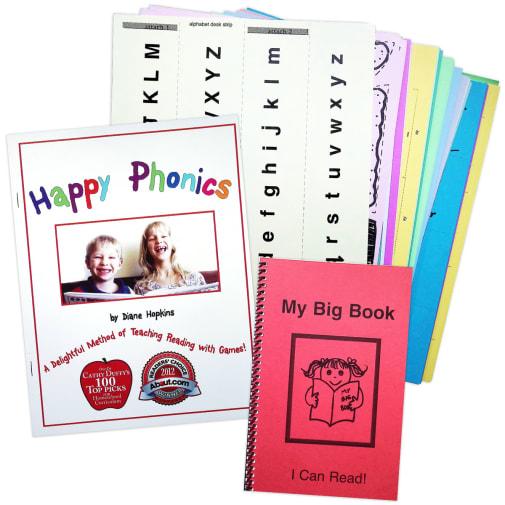From one homeschool mom to another. Everything in this program is designed to communicate "I'm a homeschool mom that taught my kids to read. It's easy. It's fun! You can do it, too. Have a great time." And I'm sure if you follow Diane Hopkins' step by step approach wrapped with loving teacher-student interaction, that's exactly the result you'll get. After going through the just-the-right-size (25 pages) Teacher's Guidebook and looking through the brightly colored cardstock that makes up the program, I'm happy with the appearance of the product and really, really impressed with the content.
Starting at the very beginning, Mrs. Hopkins has boiled the entire process down into eight steps. And even if step seven (teach phonics units containing two or more letters) has seventeen parts, she's still managed to make a homeschool mom's most fearful task into something that seems remarkably ordinary and doable.
The package contains the Happy Phonics Guidebook, "My Big Book" (an almost-to-the-end-of-the-program-reader) and lots of printed, brightly colored paper and cardstock flashcards, game components, first little readers and spelling lists. The Guidebook contains the Eight Steps along with specific how-to instructions for each step. The essence of the program is to introduce the phonics concepts a few at a time and then play games for retention. The author suggests that lesson time be about 10 minutes a day, but you may want to factor in more time to play the games over and over just because the student wants to.
The Guidebook is extremely user-friendly and written in first-person, mom-to-mom form. The step-by-step instructions are straight-forward and easy to follow. All references to the games and other supplementary material are coded with little symbols found on the colored sheets. Practically foolproof! But just to be sure, there's a chart that lists which games/components are used with each teaching step. There's also a chart clearly laying out those seventeen phonics units that make up step seven. And, of course, the teaching aids are clearly marked for each unit.
The teaching progression is common sense. Alphabet song; capital letters match lowercase letters; the main sound for each letter; blend letter sounds to form a word; teach common non-phonetic (sight) words; teach vowels that can make a second sound; teach through the phonic units; READ. Although she doesn't consider them absolutely necessary, the author does mention supplementary material that she likes and that her children have enjoyed Lauri perception puzzles, Leap Frog Phonics Library, and the Explode the Code books. In fact, she changed her original letter presentation order (used with her older children) to conform to the Explode the Code books for her younger children and in this program. She also suggests various supplementary readers.
The games and other reinforcement activities are obviously a central component of this program. Some preparation is involved, usually just cutting cards apart. I would be inclined to laminate (or cover with clear contact paper) some of the frequently-used cards and game layouts if I thought it likely I'd be using the program with a number of children. The games include some adapted favorites like Phonics Bingo and a number of creative originals like the Y Not? Game. The line art of the game components is not high tech graphics but still communicates the concept and looks inviting. Components of the games are color coded, with the little symbols marked on each game piece, so that you can easily unscramble things if they don't always get put away neatly.
This program fits into the "complete program" category of phonics instruction, as it includes systematic phonics, reinforcement, and reading practice. The program gets your student reading on his own in an enjoyable way. Please note that it does not cover advanced syllabication, prefixes, and suffixes that tend to be found in second/third grade levels of some phonics programs. But it is an enjoyable program that will build the confidence of a newbie and provide ease of instruction for busy homeschooling mothers. All for a very reasonable price! - Janice

